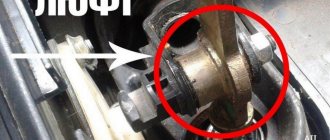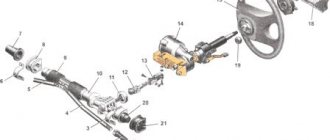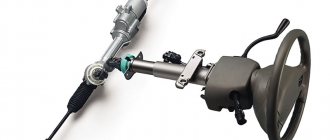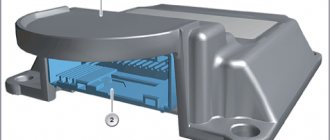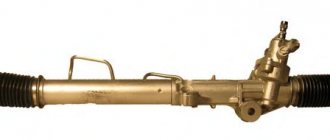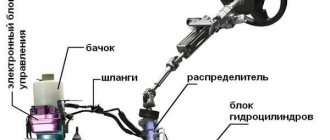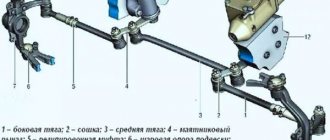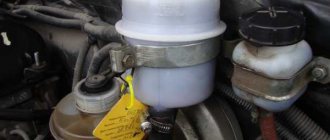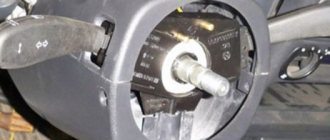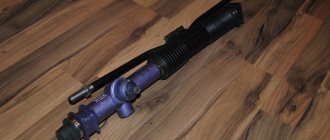Steering Regulations
Requirements for steering control elements of vehicles are regulated by UNECE Rules No. 79.
This document contains mainly design requirements for these elements. The basic operational requirements, according to which the technical condition of the steering is checked, are set out in STB 1641-2006. The total play in the steering is the angle of rotation of the steering wheel from the position corresponding to the beginning of the steering wheels turning in one direction to the position corresponding to the beginning of their turning in the opposite direction.
The total play in the steering under regulated test conditions should not exceed the limit values established by the manufacturer in the operational documentation, and in the absence of such data should not exceed:
- 10° for passenger cars and truck and bus units based on them
- 20° for buses
- 25° for trucks
The start of steering wheel rotation is the angle of rotation of the steering wheel by (0.06 ± 0.01)°, measured from the straight-line position.
When checking the total play, the following preconditions must be met:
- The steering wheel tires must be clean and dry
- the steered wheels must be in a neutral position on a dry, level, horizontal asphalt or cement concrete surface
- tests on vehicles equipped with power steering are carried out with the engine running
The value of the total play in the steering is determined by the angle of rotation of the steering wheel between two fixed positions of the beginning of rotation of the steered wheels as a result of two or more measurements.
The tension of the power steering pump drive belt and the level of working fluid in the reservoir must meet the requirements established by the vehicle manufacturer in the operating documentation.
During the organoleptic inspection of the steering system, compliance with the following regulatory requirements is checked:
- The steering wheel must rotate without jerking or jamming throughout the entire range of its rotation angle; inoperability of the power steering (if equipped on the vehicle) is not allowed
- spontaneous rotation of the steering wheel from the neutral position when the vehicle is stationary with power steering and the engine is running is not allowed
- The maximum rotation of the steering wheel must be limited only by devices provided for by the design of the vehicle
- movements of steering parts and assemblies not provided for by the design relative to each other or the supporting surface are not allowed; threaded connections must be tightened and secured in the manner specified by the vehicle manufacturer
- The use of parts with traces of residual deformation, cracks and other defects in the steering mechanism and steering drive is not allowed
Damage and absence of fastening parts of the steering column and steering gear housing, as well as increases in the mobility of steering gear parts relative to each other or the body (frame) not provided for by the vehicle manufacturer in the operational documentation are not allowed.
Mobility of the steering column in planes passing through its axis is not allowed. The steering column must be securely connected to the mating parts and not be damaged. The steering column locking device with adjustable steering wheel position, as well as the device preventing unauthorized use of the vehicle, must be in working order.
Axial movement and swing of the steering wheel plane, swing of the steering column are determined by applying alternating forces to the steering wheel in the direction of the axis of the steering shaft and in the plane of the steering wheel perpendicular to the column, as well as alternating moments of forces in two mutually perpendicular planes passing through the axis of the steering column.
The mutual movements of the steering drive parts, the fastening of the steering gear housing and the steering axle levers are determined by turning the steering wheel relative to the neutral position by 40...60° in each direction, as well as by applying an alternating force directly to the steering drive parts.
What is the beginning of a steering wheel turn?
When measuring the total steering play, it is necessary to take into account the beginning of the steering wheel rotation. To determine this parameter, it is necessary to use special equipment that allows you to recognize the movement of the steering wheel in one direction or the other by 0.06 degrees.
This value cannot be determined visually. To do this, the rotary wheels are set to the position of linear movement of the vehicle. The angle of deviation from the center point by 0.06 degrees is the beginning of the steering wheel rotation.
How many degrees of steering play is allowed according to traffic regulations in the Russian Federation?
- How many degrees of steering play is allowed according to traffic regulations in the Russian Federation?
- Permissible steering wheel play according to traffic regulations
- Diagnostics and determination of backlash
- Trouble-shooting
- Consequences
- Driving danger
- Responsibility for faulty steering
Backlash is the free movement of the steering wheel until the car begins to turn in one direction or another. It is clear that this inevitable phenomenon, characteristic of any car, should not exceed permissible limits. Read further in the article about why excess play occurs, how to eliminate it, and what punishment can be incurred for driving with a faulty car control system.
How to measure backlash
You can measure the total play at a service station or yourself. When performing the procedure, several prerequisites must be met:
- The wheels on the front axle must be in neutral. There must be a hard surface of concrete or asphalt underneath;
- the tires on the wheels must be completely dry and clean;
- the engine must be started. This criterion is relevant when performing diagnostics on a vehicle equipped with power steering;
- it is necessary to strictly comply with the manufacturer's requirements regarding the tension of the power steering drive belt, as well as the fluid level in it.
The amount of total play is determined by measuring the angle of rotation of the steering wheel in the interval between the fixed points of change in the position of the wheels (right and left). To obtain an accurate parameter, the measurement must be repeated at least two times in a row.
How to avoid getting divorced
All motorists should firmly understand that measuring the steering wheel play and prohibiting the operation of the vehicle if the indicator is above the norm is carried out only during maintenance and receipt of a diagnostic card. This knowledge will help you avoid the scam from traffic police inspectors that is popular on domestic roads.
The situation looks like this. The driver is stopped by a traffic police inspector and informed that he suspects that the steering play has exceeded the indicator. The employee offers to check the parameter on the spot and resolve the issue.
For measurement, a pre-prepared device is used, which, according to inspectors, is reliable and error-free. The result of such a check is always not in favor of the driver. An unacceptable degree of total play will be detected in the vehicle, and its owner will be offered to evacuate the car to an impound lot or “negotiate” on the spot.
Actions that a driver should take in a similar situation:
- Refuse to check the steering wheel free play indicator directly on the road (or, for example, at a stationary traffic police post). Such an examination can only be carried out at a licensed station and subject to all conditions. A current diagnostic card serves as confirmation of the vehicle's serviceability. Other roadside checks are not permitted.
- If an inspection does occur, then it is important to know that inspectors do not have the right to evacuate the car to an impound lot. The driver should insist on his rights without escalating the conflict. It is important to write down the data of the inspectors in order to appeal against their unlawful actions in the future and submit an application to the prosecutor’s office.
Diagnostics and determination of backlash
The range of play is easily determined by a play meter. For example, K524M or ISL-M, which in a couple of minutes are able to accurately set the distance of free movement of the steering wheel.
Diagnostics of the state of the car control system proceeds as follows:
- The engine starts and then idles.
- The front wheels are aligned along the longitudinal axis of the car.
- The operation of the hydraulic power steering is checked.
- The steering wheel turns alternately in one direction and in the opposite direction. In this case, it is necessary to fix the moments when the wheels begin to turn in the given vectors. The angular distance traversed by the steering wheel between these moments is the desired backlash.
It may exceed the established norm due to changes in the design features of the machine control system or due to the destruction of its parts.
Most often this happens due to:
- wear of teeth on the steering rack bar or gear;
- destruction of the wheel bearing;
- breakage of steering wheel tips and rods;
- unscrupulous repair of the vehicle chassis;
- failure of the lower or upper ball joints;
- excessive force when pulling the rack;
- old hydraulic oil;
- loose crankcase fasteners;
- wear on the pendulum arm of the axle or bushings;
- poor-quality adjustment of the clutch of the roller mechanism and the “worm”.
Possible causes of play and their diagnosis
In addition to the natural wear and tear of parts, the reason for the appearance of free play in the steering column is a consequence of a malfunction of the parts involved in driving the car. All breakdowns can be diagnosed in the following three ways.
Engine off
If increased free play is felt when the engine is off, the entire steering circuit must be checked. Here are the main problems that diagnostics can identify:
- the steering tips are worn out;
- breakage of the steering column shaft crosspiece;
- wear on the rack gear teeth;
- if the car is equipped with a steering gear (old cars in which it acts as a power steering), then play may appear in its mechanism;
- wear of the upper or lower ball joint.
When driving
If the steering wheel feels loose while driving, you need to pay attention to related problems.
- The car pulls to the side. The reason is an unadjusted wheel alignment.
- When turning the steering wheel, extraneous noise occurs. The reason is insufficient power steering fluid level.
- Knocking noise from the front end when driving on rough roads. The reason is the failure of steering rods and their tips. If this knocking sounds in the steering wheel, you need to check the steering rack.
- Steering wheel vibration. It occurs when the wheel rims are unbalanced. In addition, the cause of the steering wheel beating may be a breakdown of the ball joints or steering tips.
- Loss of smoothness. Turning the steering wheel jerkily indicates wear on the steering rack.
When braking
Free play of the steering wheel that occurs when braking may indicate the following problems:
- hub bearing failure. You can identify this damage by jacking up the car and shaking the wheel. If it is loose, then the problem is in the wheel bearing.
- after a recent repair, the chassis mechanics did not tighten the hub fastening properly;
- The steering mounting bolts are not tightened properly;
- wear of brake discs or pads.
Any changes in the car’s behavior on the road deserve the motorist’s close attention. Ignoring alarm signals is fraught not only with failure of parts, but also with the creation of an emergency situation.
Trouble-shooting
If there is excessive play in the steering wheel, you must:
- Try to adjust the screws that strengthen the universal joints and are located on the steering shaft.
- If this does not help, you should tighten the adjustment nut on the rack to eliminate the gaps between the drive gear and the gear bar.
- Adjust the steering linkage joints. If they are damaged, tighten the screws and steering rods.
- If there is no positive result, you will have to disassemble the steering structure and replace damaged parts.
Consequences
The car is an object of increased danger. If its control system is faulty, it becomes many times more dangerous.
Driving danger
It’s easy to imagine what will happen if the car’s chassis stops clearly responding to the driver’s actions. The sad consequences of this can affect not only himself and the passengers of the car, but also other road users, as well as pedestrians. In emergency situations, the driver simply will not be able to avoid danger, no matter how much driving experience he has behind him.
Responsibility for faulty steering
That is why all drivers must obey the immutable rule: if there is a malfunction in the vehicle control system, stop driving immediately . The same is officially required by traffic regulations. If the play in the vehicle's steering system exceeds the established standards, operation of this vehicle is prohibited. Ignoring this prohibition in accordance with Part 2 of Art. 12.5 of the Code of Administrative Offenses of the Russian Federation is fraught with penalties in the amount of 500 rubles. and a ban on operating the machine until the malfunction is eliminated.
The costs of towing the car to the impound lot and staying there, which accompany the ban on the operation of the car, fall on the shoulders of the careless driver.
The free movement of the steering wheel, which does not cause a change in the vehicle’s motion vector, instills anxious feelings in some drivers, while others simply do not pay attention to it. The first of them are wrong when the steering wheel play is permissible, while the second, when this value is exceeded, show criminal carelessness. In order not to go to extremes, it is enough to use a simple backlash meter to have an idea of the controllability of your car and drive calmly and safely.
Subscribe to our feeds on social networks such as Facebook, Vkontakte, Instagram, Pinterest, Yandex Zen, Twitter and Telegram: all the most interesting automotive events collected in one place.
How to remove play in the steering column
A modern car is a complex set of components and mechanisms that, unfortunately, are subject to wear and tear. The steering wheel control system wears out especially quickly due to the fact that most of its components operate under extreme conditions; a malfunction occurs, such as play in the steering. First of all, you need to keep in mind that its elimination should not be shelved, since we are talking about damage associated with a danger to the lives of not only the driver and passengers, but also other road users. And so, let’s look at the reasons why this malfunction occurs, and also find out how to remove the total play in the steering column.
Principle of operation
To understand what steering play is, consider the principle of operation of steering systems in a modern car. The steering wheel is connected through a cardan joint to a mechanism that is a hollow (usually duralumin) tube, inside of which there is a gear rack moved by a gear connected to the cardan joint. The rack is connected through internal tips to rods, which are connected through external hinges to the steering arms on the front suspension struts. Thus, any movement of the rack leads to the rotation of the wheels and any play in the steering can lead to serious consequences from a delayed reaction to movement to a complete loss of control of the car.
Causes of steering play
It is quite easy for a car enthusiast to independently determine the causes of backlash. To do this, you need to place the car on a flat area, open the hood, set the wheels in a position corresponding to straight-line movement and sharply turn the steering wheel in both directions at a small angle (for this you will need an assistant) and use your hand to feel all the components, due to a malfunction of which, play occurs in steering control. Your hand will immediately feel the faulty unit by the characteristic shift when the wheel rocks.
Loosening the nut
The most “harmless” reason for the appearance of acceptable play in the steering wheel is the weakening of the steering wheel fastening due to the loosening of the steering wheel fastening nut. To eliminate this malfunction, it is enough to remove its decorative trim and, using a socket wrench of the appropriate size, tighten the nut to the recommended torque. On most modern cars, an airbag module is installed in the steering wheel trim, which will need to be removed to provide access to the mounting nut. Therefore, all work must be carried out with special care, disconnecting the terminals from the battery.
Loosening the steering wheel nut leads to a more unpleasant problem - due to its rotation on the axle, the splines at the joint begin to wear out, which leads to loss of control. Repairs, which involve mandatory replacement of damaged parts, in this case must be carried out immediately. Wear of the universal joints on the intermediate shaft leads to the so-called “gear effect”, which manifests itself in the fact that when the steering wheel rotates, it periodically rubs. This malfunction leads to deterioration in vehicle controllability, especially at high speeds. In this case, it is necessary to replace the intermediate shaft.
Another reason that causes play in the steering wheel is loosening of the steering mechanism to the body or sedimentation of the rubber gaskets between the steering mechanism and the body. If this problem occurs, it is necessary to tighten the nuts securing the mechanism, or replace worn rubber parts. Increased clearance in the rack gears also does not bode well. It appears due to the deterioration of the contact surfaces of the rack and gear. Also, in this mechanism, the gaps between the rack and the guides relatively often increase. Moreover, the wear process accelerates significantly if the integrity of the protective anthers is damaged.
Wear of rod ends
Particularly dangerous is play in the steering, which is caused by wear on the outer rod ends. The rod ends are perhaps the most vulnerable point in the entire control system. This happens because they work in difficult conditions, constantly exposed to water, dirt, etc.
The seriousness of the malfunction is that the result is a significant increase in the axial and radial clearances in the ball joint of the tip, and, ultimately, it collapses, causing the car to lose control. It is not difficult to predict the consequences of such a malfunction, especially at high speed. In such cases, you must immediately contact a car repair shop to replace the tips.
The inner ends of the rods are attached to the steering mechanism through rubber-metal hinges pressed into their ends. If these joints wear out, a characteristic metallic knock is heard when turning the steering wheel. To eliminate this malfunction, you need to press new ones into the rods. This work requires the presence of pressing equipment, so it is best to carry out it in a car service center. Or the bolts securing the rods to the mechanism are unscrewed. In this case, to reduce and eliminate play, it is enough to tighten these bolts to the torque specified by the manufacturer.
Causes of backlash
Play in the steering appears due to wear of the working surfaces in the bearing, in the bushing, on the bipod shaft, in the T-shaped groove, in the head of the adjustment screw. In addition to increased free play of the steering wheel, wear of such parts leads to knocks and vibrations, which affects comfort and safety while driving.
Most often, the first unit where wear appears is the connection between the roller and the worm. Due to the axial displacement of the worm when turning the steering wheel at high speed, the car may lose control and get into an accident.
Basically, wear in the steering, in addition to the natural wear and tear of the contact parts, is caused by the poor condition of the roads. Although the main load when driving on such roads falls on the car’s suspension, the steering mechanism also partially suffers. Poor quality tires are also associated with such faults.
Loosening the nut
Although most of the reasons for the appearance of backlash are associated with the breakdown or wear of some component, sometimes this effect appears for rather trivial reasons. An example of this is the loosening of the nut that secures the steering wheel.
In older cars, to eliminate this effect, simply remove the decorative part of the steering wheel and tighten the nut. If the car uses an airbag installed in the steering wheel, then it must be turned off correctly so that it does not slam (for this you need to disconnect the battery).
Wear of rod ends
One of the most dangerous wear problems in the steering system is wear on the tie rod ends. These parts are constantly subject to serious stress, and they are operated in aggressive environmental conditions (constant water and dirt, and in winter also road reagents).
Due to constant loads and aggressive impact, the ball joints liners, which over time will make the car uncontrollable (the tip falls apart and the wheels turn sharply in different directions, most often this happens when turning).
In addition to the reasons listed, play in the steering may be due to:
- Collapsed wheel bearing;
- Incorrect tightening of the steering wheel nut or adjusting rods;
- Wear of ball joints;
- Wear of the joints of the cardan drive (it is used not only in car transmissions);
- Increased clearance of the bar and gear or their wear;
- Incorrectly selected hydraulic oil.
How to adjust steering play
And finally, another reason for play in the steering is loosening of the adjusting rods, which are designed to adjust the toe-in of the car's wheels. This is a consequence of poor tightening of the bolts on these rods after adjusting the toe angle, and can lead to the adjusting rod popping out of the tip.
On some modern car models, the swing arms are not welded to the suspension struts, but are bolted together. The weakening of these connections also leads to the appearance of the described trouble. To exclude this option when determining the cause that led to it, you need to lift the front of the car and remove the wheels and check the tightness of the above connections, thereby adjusting the steering.
Total play in steering
Every motorist understands perfectly well how important it is to maintain the steering system in good condition, since otherwise getting into an accident is inevitable. Play in the steering is one of the most common faults that can occur not only in old cars, but also in new ones. If this breakdown occurs, you should immediately take measures to eliminate it. If you do not do this and continue to operate the machine, then each time it will be more and more difficult to calculate the trajectory of its displacement at the stage of maneuvers.
Details about control mechanism play
To fully understand how exactly it works and how the total play is formed, you need to delve a little into how the steering system is designed. If we consider this issue from the technical side, then the situation can be described as follows. For transmission to the steering wheel, rods and a rod are used, which is initially fixed loosely, but the clearance for each car is strictly regulated.
This gap is needed to ensure that all rubbing parts do not wear out prematurely. With its presence, it will be possible to maintain engagement, but the parts will not be in full contact with the splines.
How to diagnose a malfunction?
If you sit behind the wheel and try to turn the steering wheel, there will be free movement in both directions, but only slightly. That is, at first the steering wheel will turn without effort and only then will there be a response to the wheels. Every car should have a minimum amount of play, so don't be alarmed by the fact that your new car has it.
This device allows you to significantly extend the service life of the vehicle. During intensive use of the vehicle, the total play in the steering will gradually increase until it reaches critical levels. This phenomenon will be noticeable by the slow response of the car to turning the steering wheel. When a car owner does not pay attention to this nuance in a timely manner, he may end up facing expensive system repairs, and otherwise there is a possibility of becoming a threat to the safety of movement in traffic.
What is meant by total steering wheel play?
Experts often use the expression “total play” when referring to play in a car’s steering. Let's look at what is meant by this term. In short, this is not a deviation to one side from the central position of the steering wheel before the impact on the wheels, but an indicator of the maximum deviation from one extreme point to the other.
Now a little more about how the steering works. The rod that goes into the transmission of the steering rods has a gap of a couple of millimeters. This is necessary so that wear does not form on the contact surface of the part due to the frictional force under heavy load. Thanks to this technological solution, the surface of the teeth does not wear out quickly, and the mechanism has a fairly long working life.
Visually, the presence of this gap is determined by freely turning the steering wheel until forces begin to be transmitted to the rods. This allows the driver to determine when the car begins to change direction. Some drivers think it is and try to fix it. But the complete absence of play only accelerates the wear of the rod, which is why the part will have to be replaced soon.
So, there should be play in the steering wheel. Only this parameter must be within acceptable limits. Moreover, this parameter directly depends on the dimensions of the vehicle: the larger its dimensions, the greater the amount of play allowed in it.
What causes excessive play?
Be that as it may, the cause of the play should be sought precisely in the steering system. At the initial stage, the condition of the steering rods and their tips should be assessed. It is the latter that more often than others fail when the vehicle is operated under heavy loads. If the car's wheel bearings have not been replaced for a long time, then this may be the reason for the increased free play of the steering wheel.
Also, increased play may appear almost immediately after repair work is carried out to restore the performance of the suspension. If the mechanics do not tighten the hub nut properly, the steering system will definitely not work properly.
Excessive play in the steering wheel can be caused by failure of the ball joints. The same phenomenon occurs when the steering rack is overtightened. Sometimes just changing the hydraulic oil is enough. This procedure is quite simple and can eliminate the problem that has arisen.
In any case, the fault will always lie in the control system. To identify it, you need to diagnose all the parts in detail and only after that make a decision about replacing certain components.
How to eliminate backlash?
If the clearance norm differs from the norm, meticulous diagnostics is needed:
- It is important to determine the source of the knocking. Very often, drivers think that the reason is due to free movement, but in fact the reason is related to a malfunction of another component of the vehicle.
- Check suspension operation. Often it has to be repaired or even replaced.
- Check if everything is in order with the steering bar. Sometimes, to solve the problem, it is enough to simply tighten it by turning the adjusting screw.
- Be sure to check the ball ends and rubber boots. Their replacement is also necessary quite often for the problem under consideration.
- If there are problems with the steering wheel installation, it is important to understand the reason. Most often, the root of the problem is a worn gear mount. Replacing it will quickly “calm down” the free movement.
If the above steps do not help solve your problem, think about whether you have recently repaired the chassis. A poorly tightened bearing nut can be a direct cause of problems with the steering system. If the problem is low-quality oil, as was mentioned when considering the causes, then the surest method of dealing with “played out” free wheeling is a simple oil change.
Signs of increased play
If, while driving your car, you begin to notice that it has begun to lose sensitivity to your efforts on the steering wheel, then it’s time to go to a car service center so that qualified mechanics can determine what exactly led to this effect. On average, the free play of the steering wheel should not exceed thirty millimeters. If there are any deviations, you should immediately repair your car.
There are special devices with which you can measure deviations from the norm declared by the manufacturer. It is noteworthy that if you pay attention to the malfunction in a timely manner and visit a car service center, you will not have to burden yourself with expensive repairs of the control system.
Backlashes in cars
The steering wheel free play limits for a car and a truck are different. This value, standard for each category of vehicles, is enshrined in the traffic rules. In addition, the car manufacturer can also indicate its acceptable values. The corresponding mark is made in the operating instructions or PTS.
At what value of the total backlash is vehicle operation allowed?
When identifying the permissible value, it is the total play that is taken into account, that is, the maximum angle of rotation of the steering wheel in both directions until a response is received from the wheels and the direction of movement is changed. The exact values of the total play at which the vehicle is allowed to be operated are indicated in the traffic regulations.
In some cases, a value that differs from the standard is contained in the vehicle operating documentation. There is a trend in the standard parameters - the larger the car, the higher its permissible value.
- Passenger car. For all passenger vehicles whose weight does not exceed 3.5 tons, the Rules provide for a maximum permissible value of 10 degrees. Some domestically produced cars have their own parameters. For example, for VAZ-2106, 07, 10, and 21213 - only 5 degrees.
- Truck. Cars weighing more than 3.5 tons have a maximum allowable play. The standard is 25 degrees.
- Bus. Vehicles classified as Category D may have steering wheel free play within 20 degrees.
